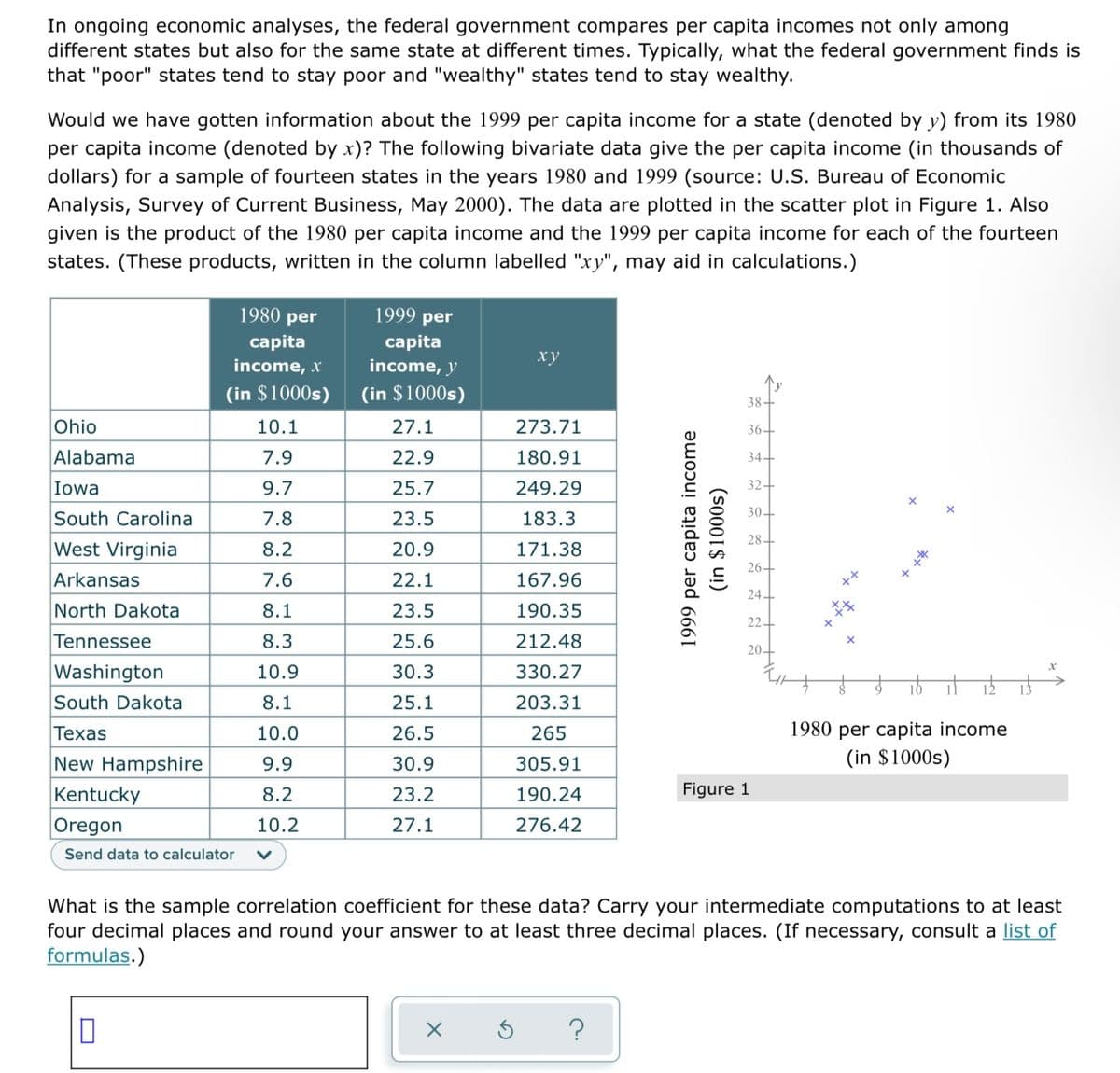In ongoing economic analyses, the federal government compares per capita incomes not only among different states but also for the same state at different times. Typically, what the federal government finds is that "poor" states tend to stay poor and "wealthy" states tend to stay wealthy. Would we have gotten information about the 1999 per capita income for a state (denoted by y) from its 1980 per capita income (denoted by x)? The following bivariate data give the per capita income (in thousands of dollars) for a sample of fourteen states in the years 1980 and 1999 (source: U.S. Bureau of Economic Analysis, Survey of Current Business, May 2000). The data are plotted in the scatter plot in Figure 1. Also given is the product of the 1980 per capita income and the 1999 per capita income for each of the fourteen states. (These products, written in the column labelled "xy", may aid in calculations.) 1980 per capita income, x 1999 per capita income, y ху (in $1000s) (in $1000s) 38+ 10.1 27.1 273.71 36- Ohio Alabama 7.9 22.9 180.91 34- Iowa 9.7 25.7 249.29 32- 30- South Carolina 7.8 23.5 183.3 28- West Virginia 8.2 20.9 171.38 26- Arkansas 7.6 22.1 167.96 24. North Dakota 8.1 23.5 190.35 Tennessee 8.3 25.6 212.48 Washington 10.9 30.3 330.27 South Dakota 8.1 25.1 203.31 Texas 10.0 26.5 265 1980 per capita income (in $1000s) New Hampshire 9.9 30.9 305.91 Kentucky 8.2 23.2 190.24 Figure 1 Oregon 10.2 27.1 276.42 Send data to calculator What is the sample correlation coefficient for these data? Carry your intermediate computations to at least four decimal places and round your answer to at least three decimal places. (If necessary, consult a list of formulas.) 1999 per capita income $1000s) (in
In ongoing economic analyses, the federal government compares per capita incomes not only among different states but also for the same state at different times. Typically, what the federal government finds is that "poor" states tend to stay poor and "wealthy" states tend to stay wealthy. Would we have gotten information about the 1999 per capita income for a state (denoted by y) from its 1980 per capita income (denoted by x)? The following bivariate data give the per capita income (in thousands of dollars) for a sample of fourteen states in the years 1980 and 1999 (source: U.S. Bureau of Economic Analysis, Survey of Current Business, May 2000). The data are plotted in the scatter plot in Figure 1. Also given is the product of the 1980 per capita income and the 1999 per capita income for each of the fourteen states. (These products, written in the column labelled "xy", may aid in calculations.) 1980 per capita income, x 1999 per capita income, y ху (in $1000s) (in $1000s) 38+ 10.1 27.1 273.71 36- Ohio Alabama 7.9 22.9 180.91 34- Iowa 9.7 25.7 249.29 32- 30- South Carolina 7.8 23.5 183.3 28- West Virginia 8.2 20.9 171.38 26- Arkansas 7.6 22.1 167.96 24. North Dakota 8.1 23.5 190.35 Tennessee 8.3 25.6 212.48 Washington 10.9 30.3 330.27 South Dakota 8.1 25.1 203.31 Texas 10.0 26.5 265 1980 per capita income (in $1000s) New Hampshire 9.9 30.9 305.91 Kentucky 8.2 23.2 190.24 Figure 1 Oregon 10.2 27.1 276.42 Send data to calculator What is the sample correlation coefficient for these data? Carry your intermediate computations to at least four decimal places and round your answer to at least three decimal places. (If necessary, consult a list of formulas.) 1999 per capita income $1000s) (in
Glencoe Algebra 1, Student Edition, 9780079039897, 0079039898, 2018
18th Edition
ISBN:9780079039897
Author:Carter
Publisher:Carter
Chapter10: Statistics
Section10.4: Distributions Of Data
Problem 19PFA
Related questions
Question

Transcribed Image Text:In ongoing economic analyses, the federal government compares per capita incomes not only among
different states but also for the same state at different times. Typically, what the federal government finds is
that "poor" states tend to stay poor and "wealthy" states tend to stay wealthy.
Would we have gotten information about the 1999 per capita income for a state (denoted by y) from its 1980
per capita income (denoted by x)? The following bivariate data give the per capita income (in thousands of
dollars) for a sample of fourteen states in the years 1980 and 1999 (source: U.S. Bureau of Economic
Analysis, Survey of Current Business, May 2000). The data are plotted in the scatter plot in Figure 1. Also
given is the product of the 1980 per capita income and the 1999 per capita income for each of the fourteen
states. (These products, written in the column labelled "xy", may aid in calculations.)
1980 per
capita
income, x
1999 per
capita
income, y
ху
(in $1000s)
(in $1000s)
38+
Ohio
10.1
27.1
273.71
36-
Alabama
7.9
22.9
180.91
34-
Iowa
9.7
25.7
249.29
32+
30-
South Carolina
7.8
23.5
183.3
28-
West Virginia
8.2
20.9
171.38
26+
Arkansas
7.6
22.1
167.96
24-
North Dakota
8.1
23.5
190.35
22-
Tennessee
8.3
25.6
212.48
20-
Washington
10.9
30.3
330.27
If 1
South Dakota
8.1
25.1
203.31
Texas
10.0
26.5
265
1980 per capita income
(in $1000s)
New Hampshire
9.9
30.9
305.91
Kentucky
8.2
23.2
190.24
Figure 1
Oregon
10.2
27.1
276.42
Send data to calculator
What is the sample correlation coefficient for these data? Carry your intermediate computations to at least
four decimal places and round your answer to at least three decimal places. (If necessary, consult a list of
formulas.)
10
?
1999 per capita income
(S000I$ u!)
X
Expert Solution
This question has been solved!
Explore an expertly crafted, step-by-step solution for a thorough understanding of key concepts.
Step by step
Solved in 3 steps with 3 images

Recommended textbooks for you

Glencoe Algebra 1, Student Edition, 9780079039897…
Algebra
ISBN:
9780079039897
Author:
Carter
Publisher:
McGraw Hill

Glencoe Algebra 1, Student Edition, 9780079039897…
Algebra
ISBN:
9780079039897
Author:
Carter
Publisher:
McGraw Hill